By Michael Perlman
mperlman@queensledger.com
Most Valentine’s Day postcards are vivid and graceful lithographs, where some feature hand-colored scenes or illustrated couples, children, cherubs and flowers, along with romantic greetings or poetry.
The majority were published between 1898 and 1918, with those from the 1920s and 1930s in fewer quantities.
Today, all are considered to be collectible works of art and range from a few dollars to over one hundred dollars, depending on their artistry, publisher and rarity.
In 1873, the first American “picture postcard” was produced. Today, a significant number of postcards from the late 19th and early to mid-20th century exist in an excellent state with fine penmanship and one-cent and two-cent stamps.
Deltiology is the collection and study of postcards, which derives from “deltion,” a Greek term for a writing tablet or letter.
A postcard collector is a deltiologist. Several decades ago, postcards could be found at a corner pharmacy, but today, vintage postcards are found on eBay and at estate sales and postcard shows.
Nearly every theme is represented, including hometowns, hobbies and holidays.
As traditional and original Valentine’s Day postcards were, innovation also made a mark. A circa late teens postcard features a girl who is a recipient of her admirer’s feelings, being transmitted through a radio receiver with headphones.
A romantic poem with unique calligraphy, particularly at the beginning of each sentence, reads: “Through the air fly with me; Where the heart is light and free, You are my love, and I am thine ~ ; Don’t say, nay, my Valentine.”
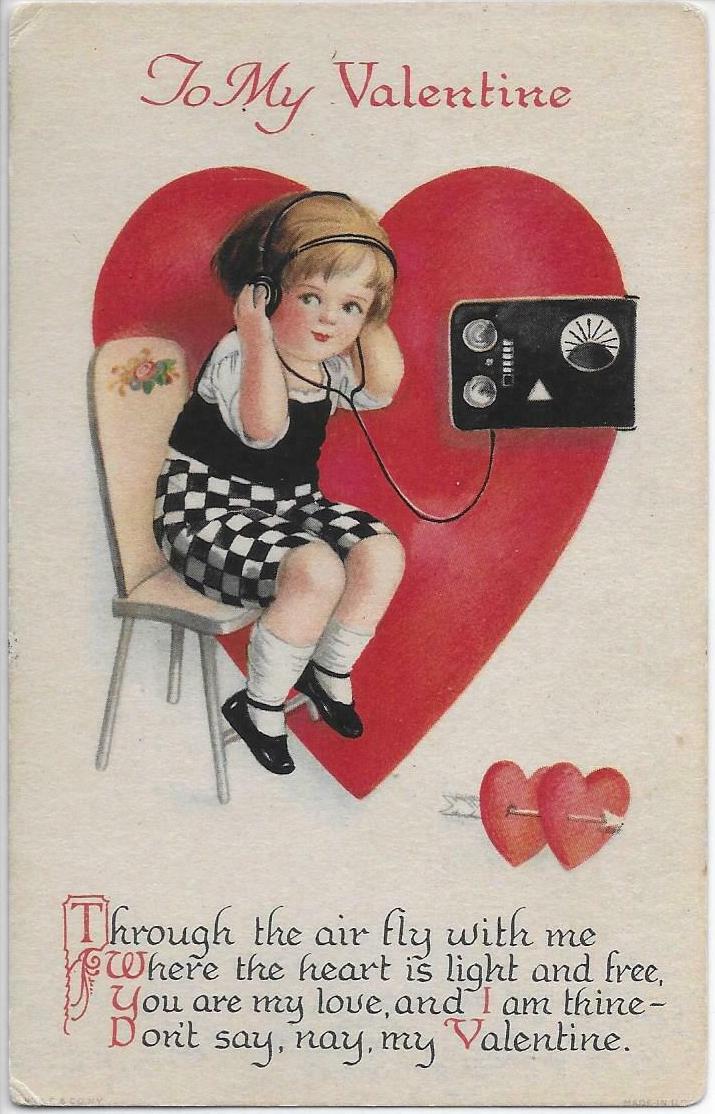
An Ellen Clapsaddle masterpiece
The spirit of early 20th century senders lives on, thanks to postcards.
A handwritten message, addressed to Bessie Pierce of Washington, PA from McDonald, PA, reads, “Don’t you think that is a nice little girl, but I know one that is a whole lot nicer, don’t you.”
The reverse bears a Wolf Advertising Co. trademark featuring a wolf in front of a globe. The design was the result of Ellen Hattie Clapsaddle (1865 – 1934), a significant artist whose style has drawn much admiration, making her a most prolific postcard and greeting card artist of her era.
She is responsible for making postcards more marketable and is credited with over 3,000 such designs. Her artwork was also featured on porcelain, trade cards, paper fans and calendars.
She was recognized for painting children of various cultures, although some of her designs feature other subjects.
Among the most graceful postcards features an elegant southern lady, wearing a Victorian-style dress in front of an ornate bridge in a garden, topped by lanterns, and experiencing “Valentine thoughts.”

Elegant John Winsch postcard
Embossed red and gold hearts and ornate gold and floral motifs lend to its Art Nouveau feel.
This design was copyrighted in 1913 by prominent artist John Winsch (1865 – 1923) of Stapleton, New York. He was co-manager of Art Lithographic Publishing Co.
Many of his cards were published in sets, and he produced approximately 4,000 designs between 1910 and 1915.
He was highly recognized for his holiday themes, as well as his use of European artists who worked with his German printers.
A circa 1914 Auto Series postcard can be considered a crossover postcard under daily romance and Valentine’s Day themes.
Bright large flowers add character to a shaded forested pathway, where couples in fashionable period attire are ready to embrace in a classic automobile and while taking a leisurely stroll.
This postcard evokes the ambiance of the classic “Lovers’ Lane,” characterized by an off the beaten track narrow dirt road accompanied by hedges and trees, where people make out. This phrase appeared in the Oxford English dictionary as early as 1853.
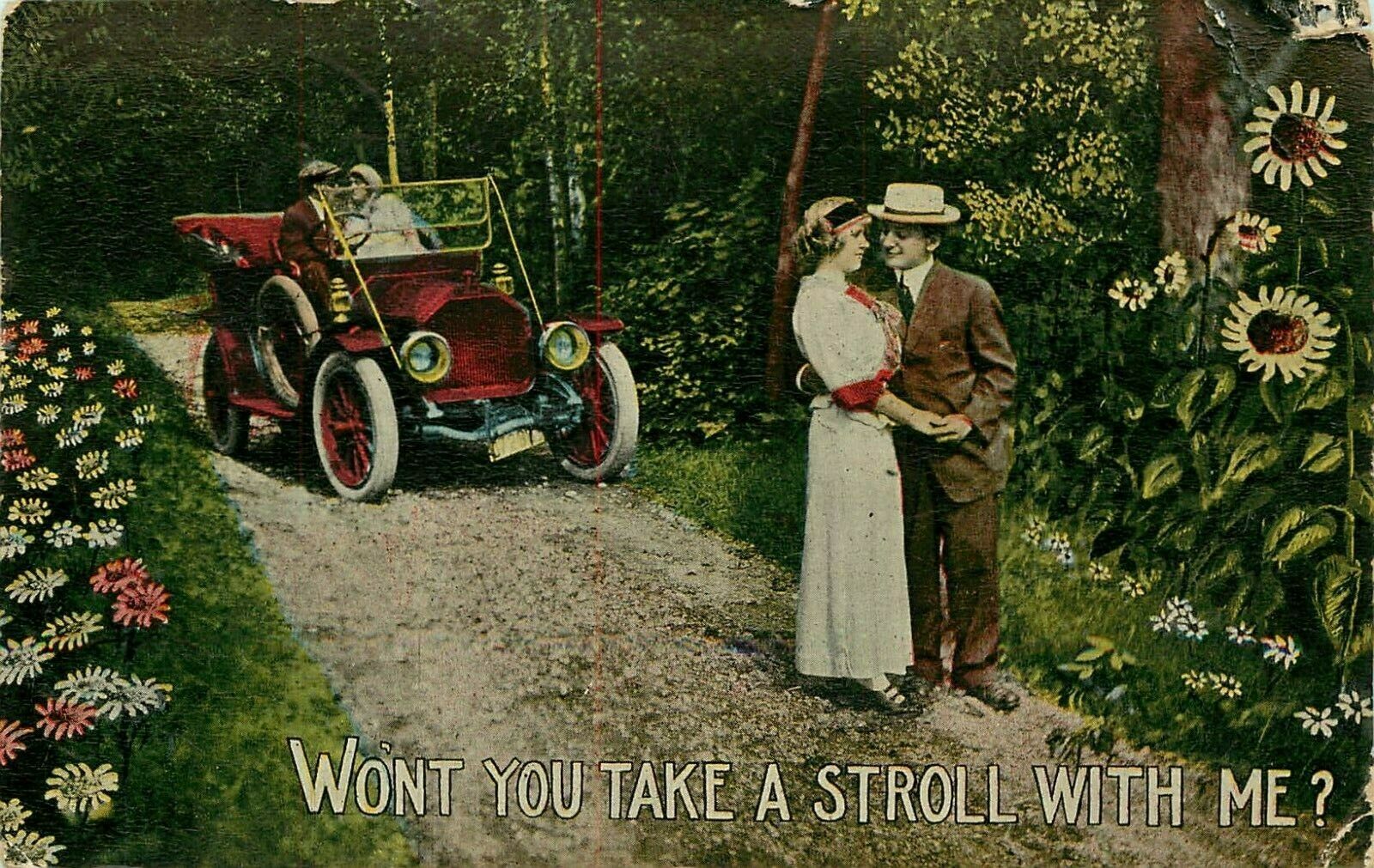
Carl Benz was the first to apply for a patent for a vehicle powered by a gas engine in 1886, so as of this circa 1914 postcard, the advent of the automobile was still being celebrated.
During the Victorian era and shortly after, a charming porch was a commonality for transitioning from a front garden into a home.
Sitting on a rose-embellished porch is a mother on a rocking chair, reading a book. Several decades ago, it was customary to ask one’s parents if they could court a significant other. “Oh, go ahead. Ask her if I can be your Valentine,” said a girl to a boy. The children dressed up for the occasion, ribbon and all.
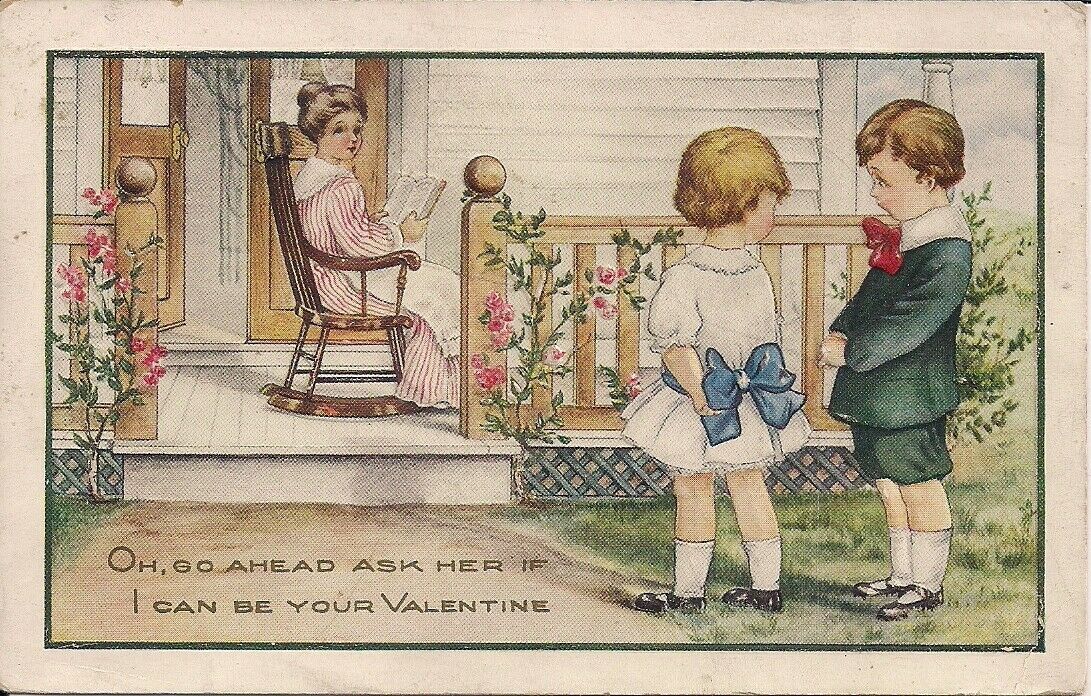
Children courting, A Whitney gem
This circa 1910 postcard features elegant typography, where “Post Card” is surrounded by a Colonial feather-like design and below reads, “Whitney Made Worcester, Mass.”
The Geo. C. Whitney Company’s principal was George Clarkson Whitney (1842 – 1915), whose motto was “Industry, punctuality and Christianity.” His firm became a notable publisher of postcard greetings and holiday cards on specialty papers. The center of the American Valentine industry was based in Worcester, thanks to his dedication.
In 1915, “Worcester Magazine” published, “Ninety percent of the valentines that are exchanged on St. Valentine’s Day come from Worcester.” One noteworthy principle that distinguished Whitney is that he did not support “using love’s gifts as a medium for ridicule.” His son Warren and grandson George assumed the operations, but as of 1942, the largest and earliest manufacturer of valentines worldwide, shuttered.
An attractive brunette or blonde woman poses in varying directions within a heart in this 1910 Fortune Valentine Series of postcards, which read “To my Valentine” and “Queen of my Heart.”
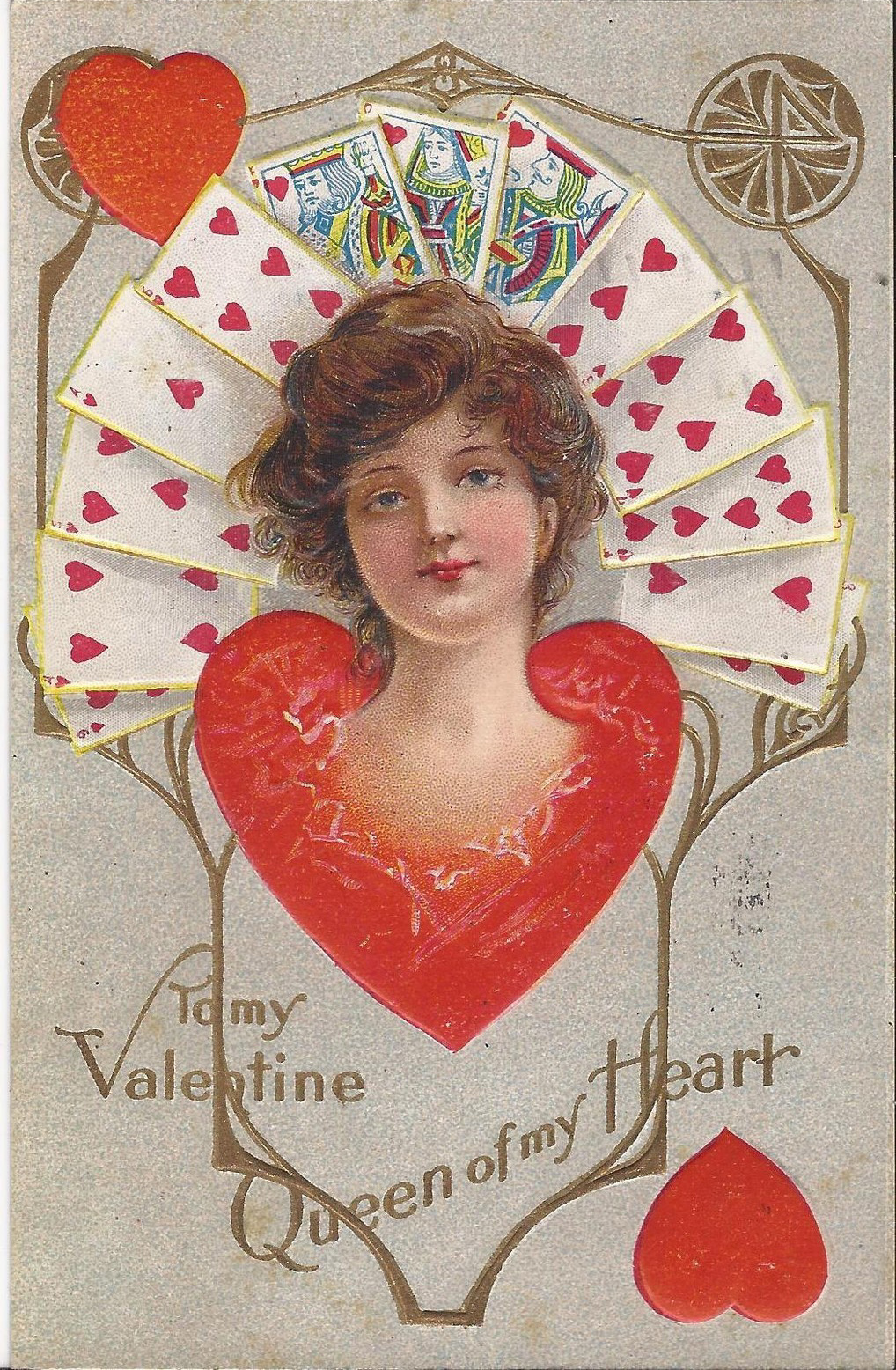
Fortune Valentine Series by E Nash
The heart-themed playing cards, distinguished by their layout within the series, consistently reveal kings and queens. Gold or silver gilded Art Nouveau motifs contribute to its regal nature.
This series was produced by the New York City-based E. Nash Company, which was in operation from 1908 to 1910, and was regarded as a well-respected publisher and illustrator of holiday and patriotic postcards.
Some postcards are highly desirable as a result of their ornate designs that dominate the space.
All eyes are on a couple kissing within a heart, which is surrounded by a series of gold embossed frames dotted with distinctive hearts and pastel backdrops. The background resembles a parchment paper with horns upon the uppermost curves. Below the heart is a ribbon adorned basket of hearts and feathers. This 1910 postcard is unmarked by a publisher and unsigned by an artist, which adds to the mystery of determining a postcard’s history.
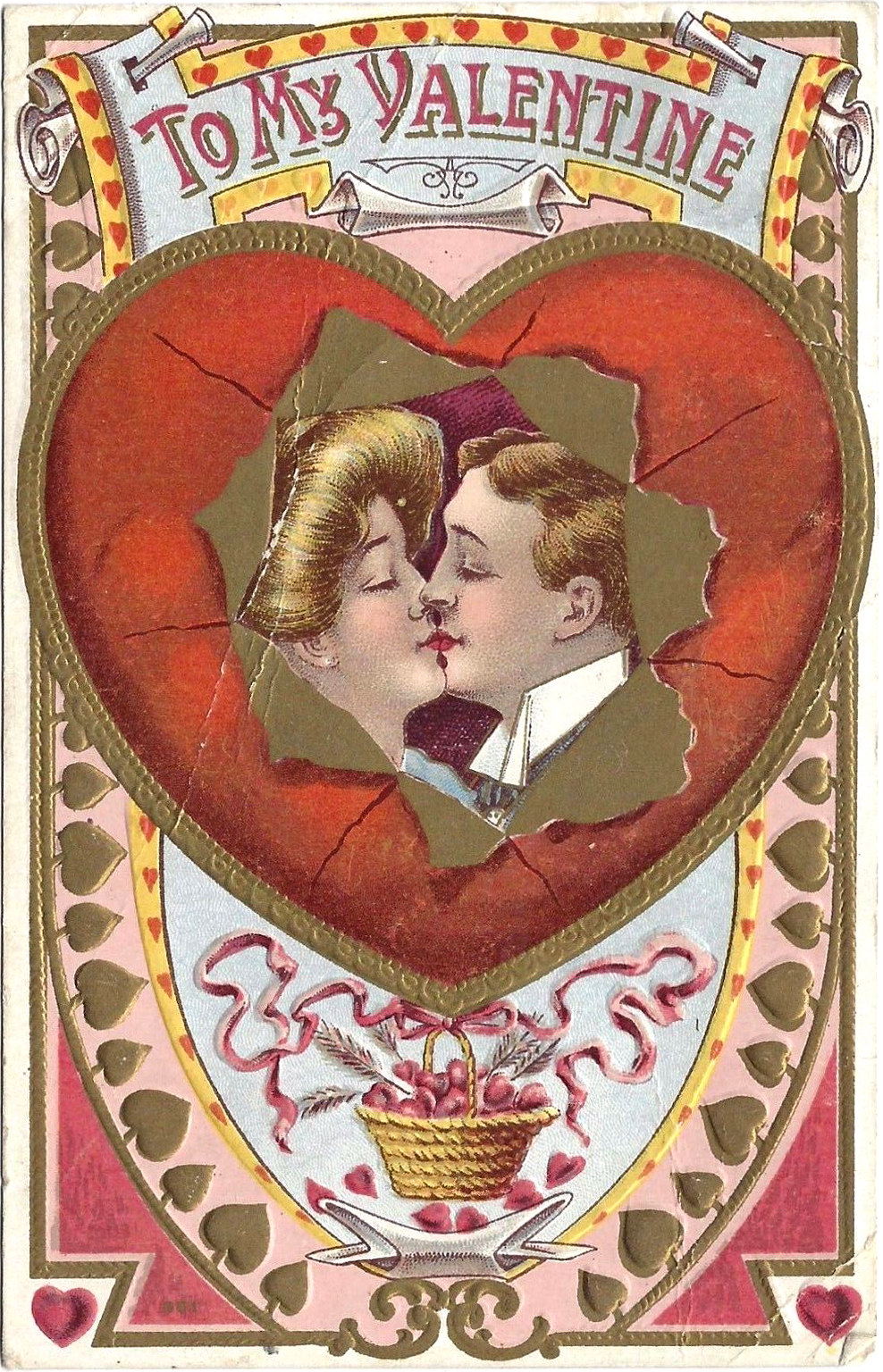
It was the end of an era in 2010, when the longtime Buster Brown Shoes, with its animated Buster Brown and dog Tige caricature sign at 71-24 Austin Street, shuttered.
Buster Brown originated in 1902 by Richard F. Outcault (1863 – 1928), a pioneer in the modern comic strip. This postcard asks, “Will you be my valentine? Read the answer in the stars,” and the stars indeed respond.
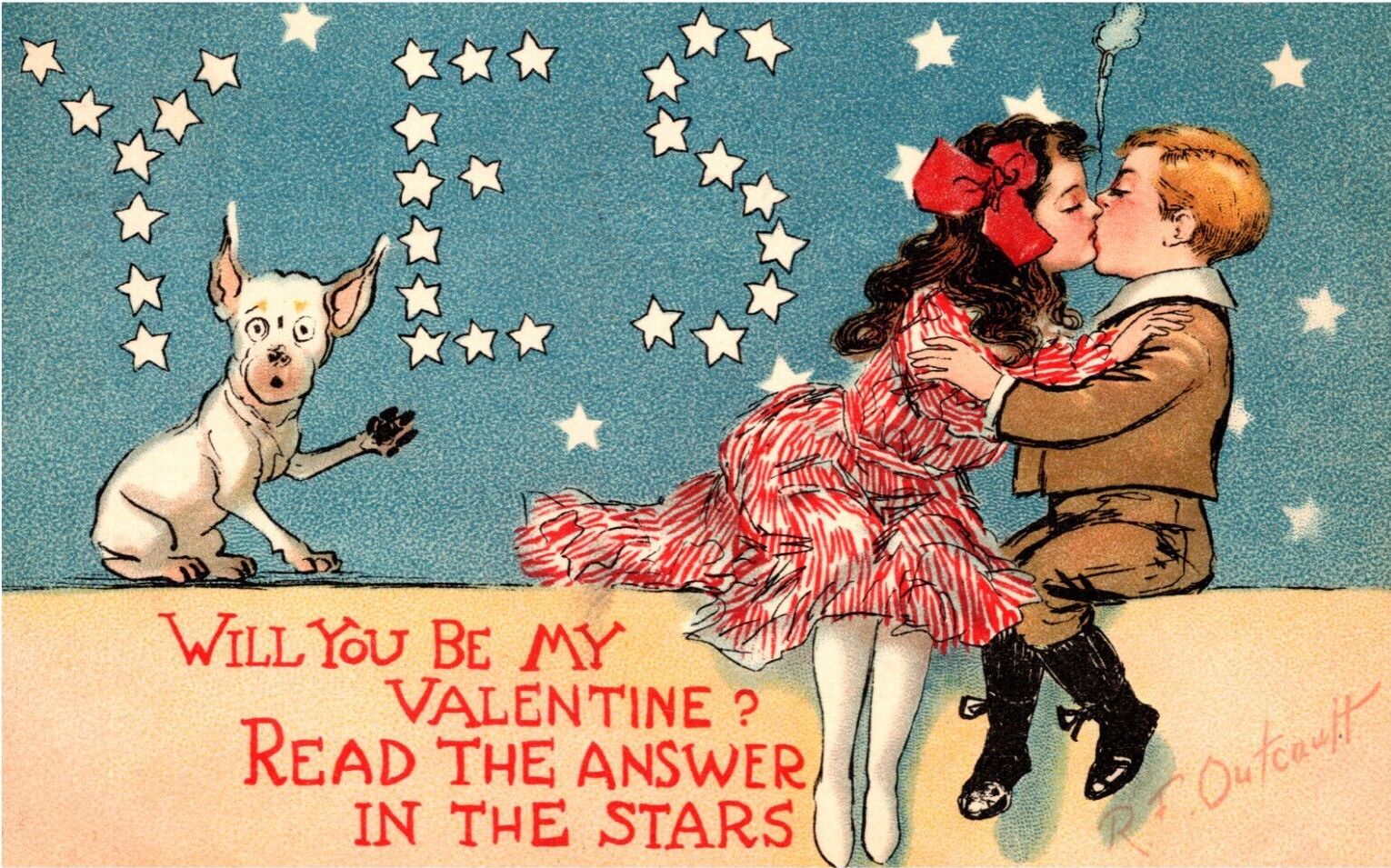
Such Outcault signed Buster Brown and Tige series postcards (Valentine Series No. 112) were among many humorous and romantic themed postcards by Raphael Tuck & Sons.
This prominent publishing firm was founded in London by Raphael Tuck (1821 – 1900) and operated from 1866 to 1959. Other addresses included Paris, Berlin, Montreal, and 298 Broadway and 122 – 124 Fifth Avenue in Manhattan.
In 1894, his son, Adolph Tuck, created their first picture postcard. The firm was referenced as “Art publishers to their majesties the king and queen,” since Queen Victoria granted the Royal Warrant of Appointment in 1883.



